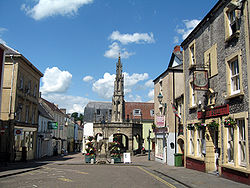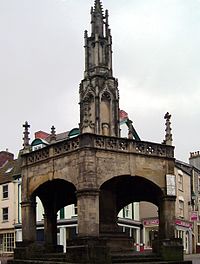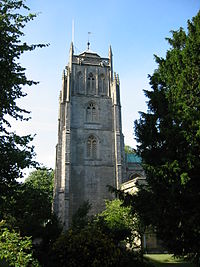Shepton Mallet
| Shepton Mallet | |
| Somerset | |
|---|---|
 Shepton Mallet marketplace | |
| Location | |
| Grid reference: | ST619438 |
| Location: | 51°11’35"N, 2°32’46"W |
| Data | |
| Population: | 9,700 |
| Post town: | Shepton Mallet |
| Postcode: | BA4 |
| Dialling code: | 01749 |
| Local Government | |
| Council: | Mendip |
| Parliamentary constituency: |
Wells |
Shepton Mallet is a small rural town in Somerset, some 18 miles south of Bristol and 5 miles east of Wells. The town is estimated to have a population of 9,700.
The Mendip Hills lie to the north, and the River Sheppey runs through the town. Shepton Mallet lies on the route of the Fosse Way, the principal Roman road into the south west of Britain, and there is evidence of Roman settlement. The town contains a fine parish church and a considerable number of listed buildings. Shepton Mallet Prison was Britain's oldest prison still in use until its closure in March 2013.
In the Middle Ages, the wool trade was important in the town's economy, although this declined in the 18th century to be replaced by other industries such as brewing; the town continues to be a major centre for the production of cider. Shepton Mallet is the closest town to the site of the Glastonbury Festival, the largest music festival in Europe. Also nearby is the Royal Bath and West of England Society showground which hosts the Royal Bath and West Show, and other major shows and festivals.
Contents
Name
The name Shepton derives from the Old English sceap tun, meaning 'sheep village'. The Domesday Book of 1086 records a settlement known as Sceaptun.[1] The current spelling is recorded at least as far back as 1496, in a letter from King Henry VII. The second part of the name derives from that of the Norman family of Malet, who took a lease from Glastonbury Abbey around 1100. The second 'L' appears to have been added in the 16th century.[2][3]
History
Early Shepton
Archaeology has found abundant traces of Stone Age, Bronze Age and Iron Age presnece across the landscape. Roman remains are few apart from one major mark on the land: the Fosse Way Roman road, and burials along it, and several Roman coin hoards have turned up.
There is a small amount of evidence of Anglo-Saxon settlement in Shepton Mallet, apart from the town's very name, including some Saxon stonework in the parish church, St Peter and St Paul. In 706 King Ine of Wessex granted a charter giving the estate here to Abbot Berwald of Glastonbury Abbey.[2] According to some legends Indract of Glastonbury was buried in Shepton.[4]
The Exeter Domesday Book records that in the days of King Edward the Confessor (which is to say before the Norman Conquest in 1066) the manor was held by Uluert, and by 1086 it was held by Roger de Corcella. When Roger de Corcella died, sometime before or around 1100, the land passed to the Malet family, a very prominent Norman family, who caused their name to be added to that of the village, as also to another of their holdings at Curi, now known as now Curry Mallet.[2][5][6][7]
Middle Ages
The Malet family retained the estate until the reign of King John]], when on the death of William Malet it passed through his daughter Mabel to her husband Hugh de Vivonne and some generations later part was sold to a relative, Sir Thomas Gournay. His son, also called Thomas, participated in the murder of Edward II, and his estates were confiscated by Edward III in 1337. However the family regained favour with the King some years later, and the lands were returned. When Mathew de Gournay died childless in 1406, the estate again reverted to the Crown, before being granted out to Sir John de Tiptoft. It was once again confiscated from his son by Henry VI during the Wars of the Roses (due to the family siding with Edward IV), but was restored to Sir John's grandson, Edward Tiptoft, when Edward IV regained the throne. Glastonbury Abbey held the manor at the Dissolution of the Monasteries under Henry VIII, when the Abbey's lands, including Shepton Mallet, were granted to the Duchy of Cornwall in 1536.[2][8]
Charters for the holding of markets and fairs were granted in 1235 (though this charter was swiftly revoked following objections by the Bishop of Wells to the competition it represented to the market in that city), 1260 and 1318, and the town prospered until struck by the Black Death in 1348, which reduced the population to about 300.[5]
Modern Era
As the modern era began, Flemish and Huguenot craftsmen and merchants from France and the Low Countries brought new techniques in cloth-making which made Shepton, steeped in wool, a rich town.
In 1625, a House of Correction was established in Shepton Mallet.[9][10]
In the Civil War the town supported the parliamentary side, although Shepton appears to have mostly escaped conflict apart from a bloodless confrontation between supporters of the King, led by Sir Ralph Hopton, and Parliament, led by Colonel William Strode, in the market place on 1 August 1642.[2][5] In 1645 Sir Thomas Fairfax led the New Model Army through the town on the way to capturing Bristol,[1] and in 1646 the church organ was apparently destroyed by Cromwellian soldiers.[11][2]
During the Monmouth Rebellion in 1685, the Duke of Monmouth was welcomed when he passed through Shepton Mallet, staying in Longbridge House[12] in Cowl Street on the night of 23 June, with his men quartered throughout the town. Twelve local supporters of Monmouth were hanged and quartered in the Market Place of the town after the rebellion failed.[13][2][5][14]
In 1699 Edward Strode built almshouses, close to the rectory his family had built to house the town's grammar school, which lasted until 1900.[1]
Discontent at the introduction of mechanisation into the mills resulted in the deaths of two men in a riot in the town in 1775, an event which apparently discouraged the mill-owners from pursuing modernisation,[5][15] so Shepton's cloth trade declined faced with steam-powered mills in the West Riding of Yorkshire and in Lancashire. The manufacture of silk and crepe revived the town's fortunes somewhat,[16] and Shepton's mills manufactured the silk used in Queen Victoria's wedding dress.[5] However these industries also eventually died out.
For a period during Second World War, Shepton Mallet Prison was used to store important national records from the Public Record Office, including Magna Carta, the Domesday Book, the logbooks of HMS Victory, dispatches from the Battle of Waterloo, and the "scrap of paper" signed by Hitler and Prime Minister Neville Chamberlain at the Munich Conference of September 1938. The Prison also became a US Army detention facility, and between 1943 and 1945 eighteen American servicemen were executed within the prison walls after court-martial.
Parish church
The Grade I listed parish Church of St Peter and St Paul dates from the 12th century, but the current building is largely from the 15th century, with further rebuilding in 1836. The oak wagon roof, made up of 350 panels of different designs, separated by 396 carved foliage bosses (supposedly every one different) and with 36 carved angels along the sides, was described by Nikolaus Pevsner as the finest 15th century carved oak wagon-roof in the land. It was restored, at a cost of £5,000, in 1953–54.[2][17][18]
Events
- Collett Day is the town fete, held in June in the town's Collett Park.
- Two annual agricultural shows are held close to the town: the four-day Royal Bath and West Show, which is held at the showground of the Royal Bath and West of England Society near Evercreech, 2½ miles southeast of the town, while the one-day Mid-Somerset Show is held on fields on Shepton Mallet's southern edge.
- At Bath and West Showground:
- New Wine
- Soul Survivor
- Shepton Mallet International Antiques & Collectors' Fair
- National Amateur Gardening Show
- National Adventure Sports Show.
Media
- Newspaper:
- The Shepton Mallet Journal
- Fosse Way Magazine
- Mendip Times
Sport
- Football: Shepton Mallet FC
Outside links
| ("Wikimedia Commons" has material about Shepton Mallet) |
- Shepton Mallet Online (Town Council)
References
- ↑ 1.0 1.1 1.2 Bush, Robin (1994). Somerset: The Complete Guide. Wimborne: Dovecote Press. pp. 179–181. ISBN 1-874336-26-1.
- ↑ 2.0 2.1 2.2 2.3 2.4 2.5 2.6 2.7 Ford, Eric: Shepton Mallet: An Historical and Postal Survey (1958, self-published)
- ↑ Robinson, Stephen (1992). Somerset Place Names. Wimborne, Dorset: The Dovecote Press Ltd. ISBN 1-874336-03-2.
- ↑ Robinson, W.J. (1915). West Country Churches. Bristol: Bristol Times and Mirror Ltd. pp. 144–149.
- ↑ 5.0 5.1 5.2 5.3 5.4 5.5 Davis, Fred; Blandford, Alan; and Beckerleg, Lewis: The Shepton Mallet Story (2nd Ed) (1977, The Shepton Mallet Society ISBN 978-0-9500568-1-4
- ↑ Shepton Mallet Norman History (Shepton Mallet Town Council)
- ↑ Shepton Mallet Middle Ages History (Shepton Mallet Town Council)
- ↑ Farbrother, John E. (1872). Shepton Mallet: Notes on its History, Ancient, Descriptive and Natural (Memorial Edition). Bridgwater: Reprinted by Somerset County Library 1977. pp. 7–11. ISBN 0-9503615-3-4.
- ↑ Historic Buildings of Shepton Mallet - Shepton Mallet Town Council
- ↑ Disney, Francis (1992). Shepton Mallet Prison (2nd Ed). Published by the Author. ISBN 0-9511470-2-1. Also in updated form as a CD-ROM (2001), see "Shepton Mallet Prison: 390 years of prison regime"
- ↑ Farbrother, John E. (1872). Shepton Mallet: Notes on its History, Ancient, Descriptive and Natural (Memorial Edition). Bridgwater: Reprinted by Somerset County Library 1977. p. 14. ISBN 0-9503615-3-4.
- ↑ National Heritage List 1296498: Longbridge House
- ↑ Farbrother, John E. (1872). Shepton Mallet: Notes on its History, Ancient, Descriptive and Natural (Memorial Edition). Bridgwater: Reprinted by Somerset County Library 1977. pp. 16–20. ISBN 0-9503615-3-4.
- ↑ Shane Scott: The hidden places of Somerset (1995, Travel Publishing Ltd) ISBN 1-902007-01-8, p56
- ↑ Farbrother, John E. (1872). Shepton Mallet: Notes on its History, Ancient, Descriptive and Natural (Memorial Edition). Bridgwater: Reprinted by Somerset County Library 1977. p. 25. ISBN 0-9503615-3-4.
- ↑ Farbrother, John E. (1872). Shepton Mallet: Notes on its History, Ancient, Descriptive and Natural (Memorial Edition). Bridgwater: Reprinted by Somerset County Library 1977. pp. 26–27. ISBN 0-9503615-3-4.
- ↑ Leete-Hodge, Lornie (1985). Curiosities of Somerset. Bodmin: Bossiney Books. p. 20. ISBN 0-906456-98-3.
- ↑ National Heritage List 1345202: Church of St Peter & St Paul

